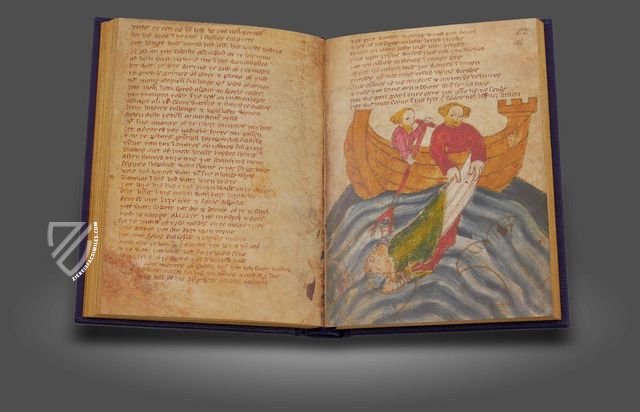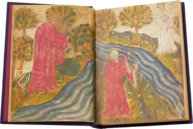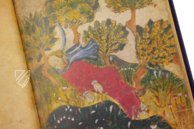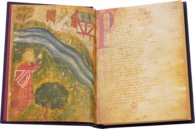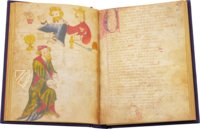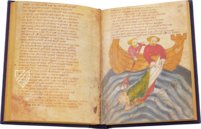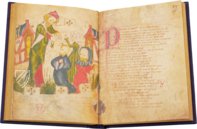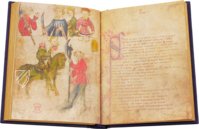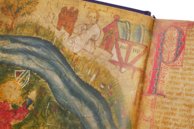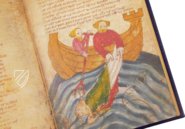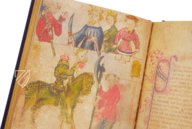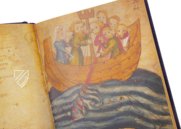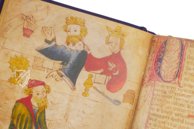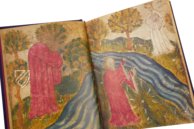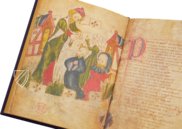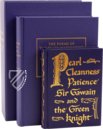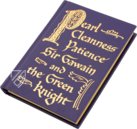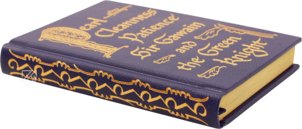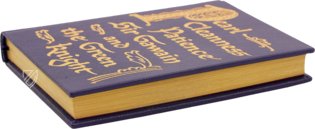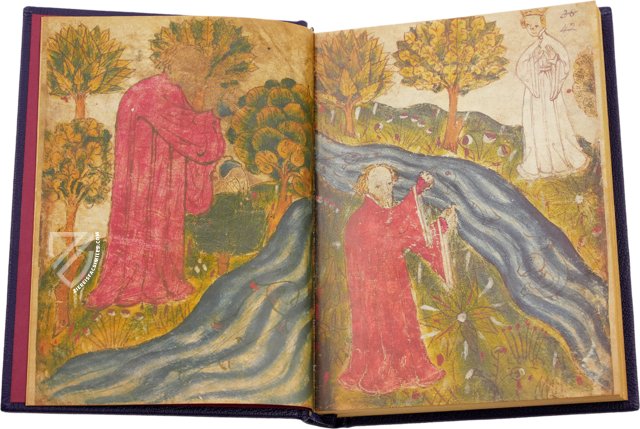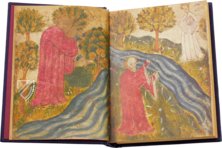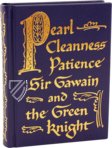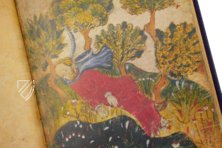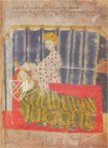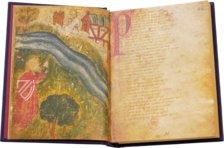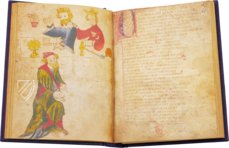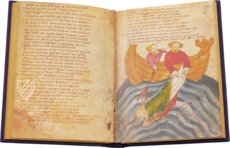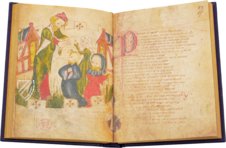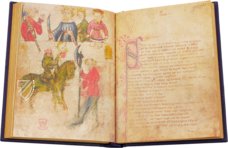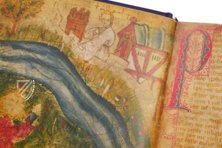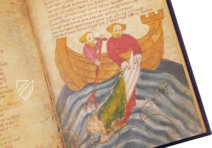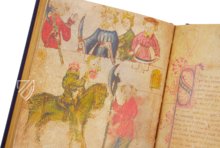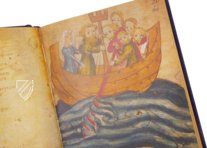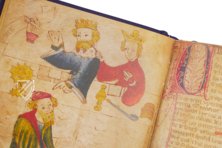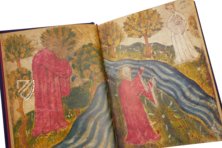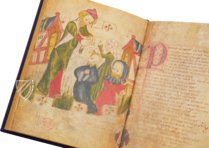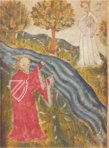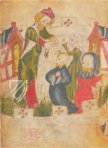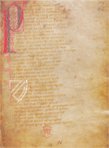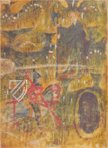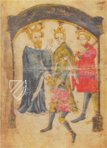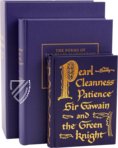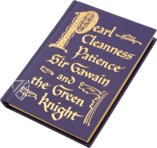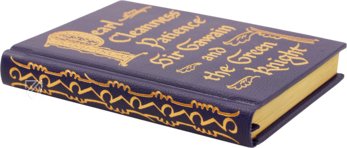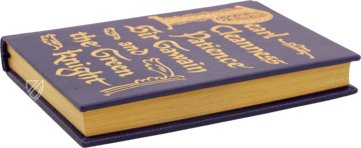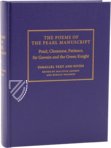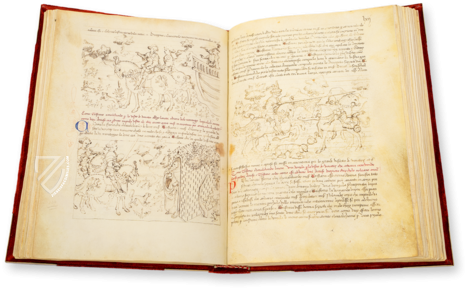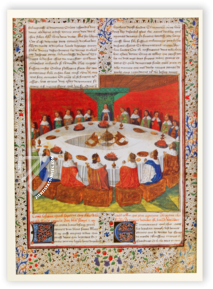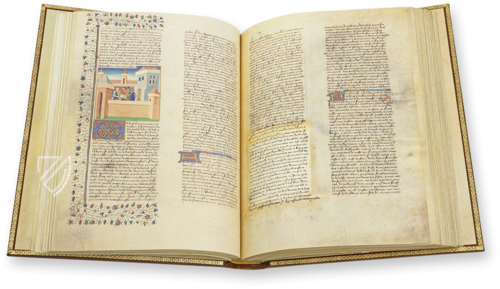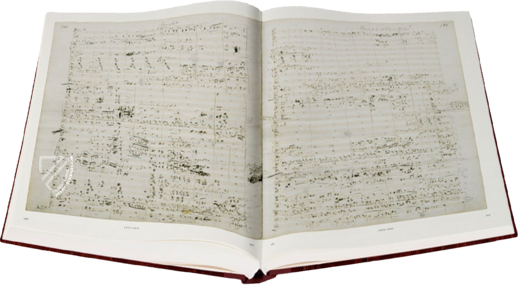Pearl Manuscript
(1,000€ - 3,000€)
The only source for four extremely charming Arthurian legends to survive to the present originated in southern England during the second half of the 14th century. The poems Pearl, Cleanness, Patience, and Sir Gawain and the Green Knight all probably originated from one author and testify to the literary flowering of 14th century England with their creativity. The twelve full-page miniatures, which accompany each poem and impressively visualize them for the beholder, are also probably from the same hand. The decoration is complimented by a total of 48 initials in red and blue that visualize certain sections of the allegorical poems.
The Pearl Manuscript
The Pearl Manuscript is one of the most important manuscripts of English literature and its texts testify to the impressive flowering of literary creativity at the end of the 14th century. The four poems Pearl, Cleanness, Patience, and Sir Gawain and the Green Knight all belong to the genre of Arthurian literature and probably originate from the same author. This person was also probably responsible for the twelve full-page miniatures, which accompany each poem. Originating in the second half of the 14th century, the precious manuscript barely escaped destruction in 1731 when a fire destroyed the library of the antiquarian Robert Cotton (1571–1631) and a large number of medieval manuscripts fell victim to the fire.
Four Allegorical Poems
The collection is named after the first poem, Pearl, which tells the tale of a grieving father, who after falling asleep finds himself in paradise and engages in a dialogue about Christian doctrine. As he awakes from this dream, he is filled with spiritual power and new confidence. The most famous of the four poems is, nevertheless, Sir Gawain and the Green Knight. It was first published in 1839 with other Gawain stories. The other three texts followed a short time later.
An Exciting Chivalric Romance
The Middle English chivalric romance Sir Gawain and the Green Knight tells the tale of Sir Gawain, who accepted the Green Knight’s challenge to behead him. However, this came with the condition that he himself will suffer the same fate one year and one day later. After the beheading of the knight, Sir Gawain begins his journey to the place where his fate will come to pass. It is his courage that makes him the ultimate example of the chivalric codex.
The Question of the Author
The Pearl Manuscript represents the only source for all four poems and is of particular significance for research as a result. Who the author of these fairy-tale Arthurian legends is remains a mystery. Due stylistic similarities, such as the usage of alliteration, abstract ideas, and a strong Christian orientation, have prompted the assumption that all four poems stem from one author, who has been given the provisional names Pearl Poet or Gawain Poet.
Codicology
- Alternative Titles
- Pearl Manuskript
- Size / Format
- 184 pages / 17.1 × 12.0 cm
- Origin
- United Kingdom
- Date
- Second half of the 14th century
- Epochs
- Style
- Genre
- Language
- Script
- Variant of the Gothic Textura Rotunda with features of the Anglicana
- Illustrations
- 12 full-page miniatures; 48 fleuronné initials in blue and red
- Content
- 4 allegorical poems: Pearl (ff. 41r-59v), Cleanness (ff. 60r-86r), Patience (ff. 86r-94r), and Sir Gawain and the Green Knight (ff. 94v-130r)
- Artist / School
- Pearl poet / Gawain poet
- Previous Owners
- Henry Savile of Bank in Yorkshire
Robert Cotton (1571–1631)
Pearl Manuscript
The Temptation of Sir Gawain by Lady Bertilak
In the poem Sir Gawain and the Green Knight, Lady Bertilak plays the role of seductress when she is ordered to seduce Sir Gawain in order to test his purity. Depicted caressing the sleeping Gawain’s beard, she comes to his bedchamber at dawn three mornings in a row, appearing more alluring each time and tempts him with various objects that she claims will protect him. Gawain eventually gives in and accepts a green girdle with protective properties that he will use in his battle with the Green Knight.
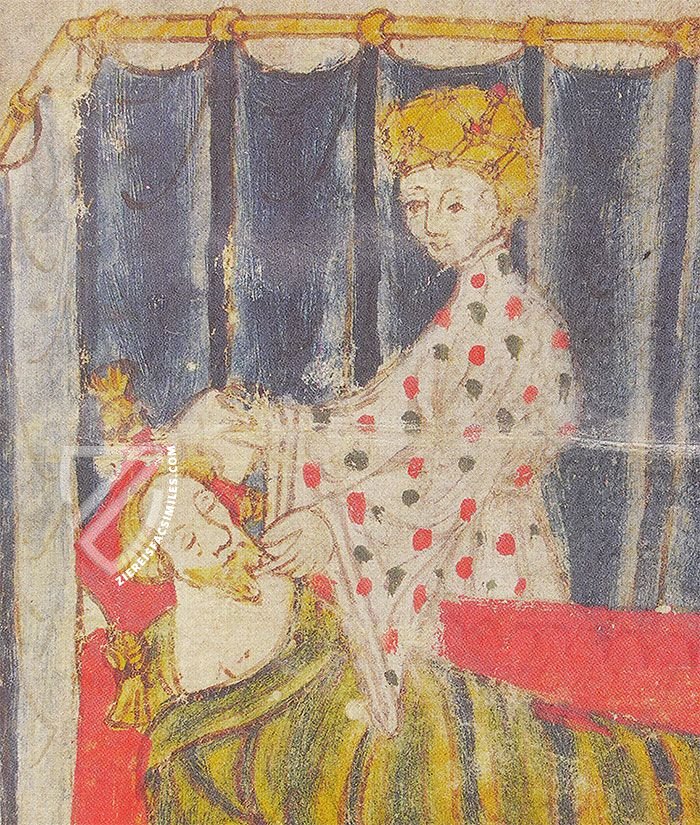
Pearl Manuscript
The Dreamer and the Pearl-Maiden
Considered to be one of the most important works written in Middle English to survive today, the poem Pearl concerns a father mourning the loss of his “Pearl”. He falls into a sleep while in his garden and encounters a beautiful divine woman, the Pearl-Maiden, who he sees standing on the other side of a stream, but when the Dreamer attempts to cross it, he wakes up.
The dreamer is dressed in a red houppelande, a long, loose-fitting robe with flared sleeves that was popular in the late 14th and 15th centuries, especially in England. On the other side of a stream filled with fish, the Pearl-Maiden is crowned and dressed in white. The number 38 has been crossed out and replaced with a 42, a sign that the foliation was corrected at some point.
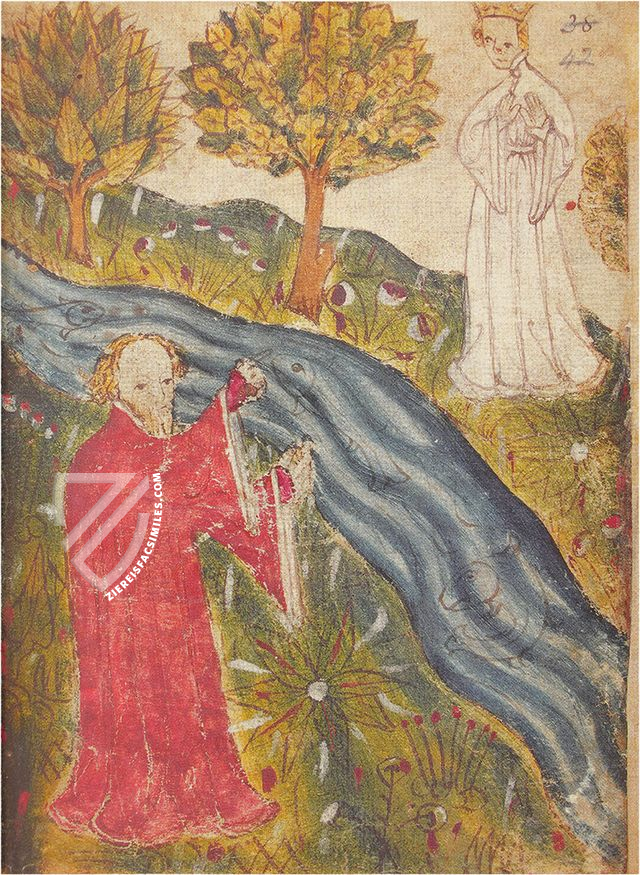
#1 The Pearl Manuscript
Language: English
The commentary volume contains a comprehensive introduction to the manuscript, its contents, origin, and history. It also provides an accurate transcription of the original Middle English texts as well as a modern translation. First published in 1978 by medievalists Malcolm Andrew and Ronald Waldron, it appeared in 2007 in the fifth revised edition that accompanies this facsimile edition and is still the standard work on the Pearl Manuscript. The preface was written by the poet and medievalist Bernard O'Donoghue.
(1,000€ - 3,000€)
- Treatises / Secular Books
- Apocalypses / Beatus
- Astronomy / Astrology
- Bestiaries
- Bibles / Gospels
- Chronicles / History / Law
- Geography / Maps
- Saints' Lives
- Islam / Oriental
- Judaism / Hebrew
- Single Leaf Collections
- Leonardo da Vinci
- Literature / Poetry
- Liturgical Manuscripts
- Medicine / Botany / Alchemy
- Music
- Mythology / Prophecies
- Psalters
- Other Religious Books
- Games / Hunting
- Private Devotion Books
- Other Genres
- Afghanistan
- Armenia
- Austria
- Belgium
- Belize
- Bosnia and Herzegovina
- China
- Colombia
- Costa Rica
- Croatia
- Cyprus
- Czech Republic
- Denmark
- Egypt
- El Salvador
- Ethiopia
- France
- Germany
- Greece
- Guatemala
- Honduras
- Hungary
- India
- Iran
- Iraq
- Israel
- Italy
- Japan
- Jordan
- Kazakhstan
- Kyrgyzstan
- Lebanon
- Liechtenstein
- Luxembourg
- Mexico
- Morocco
- Netherlands
- Palestine
- Panama
- Peru
- Poland
- Portugal
- Romania
- Russia
- Serbia
- Spain
- Sri Lanka
- Sweden
- Switzerland
- Syria
- Tajikistan
- Turkey
- Turkmenistan
- Ukraine
- United Kingdom
- United States
- Uzbekistan
- Vatican City
- A. Oosthoek, van Holkema & Warendorf
- Aboca Museum
- Ajuntament de Valencia
- Akademie Verlag
- Akademische Druck- u. Verlagsanstalt (ADEVA)
- Aldo Ausilio Editore - Bottega d’Erasmo
- Alecto Historical Editions
- Alkuin Verlag
- Almqvist & Wiksell
- Amilcare Pizzi
- Andreas & Andreas Verlagsbuchhandlung
- Archa 90
- Archiv Verlag
- Archivi Edizioni
- Arnold Verlag
- ARS
- Ars Magna
- ArtCodex
- AyN Ediciones
- Azimuth Editions
- Badenia Verlag
- Bärenreiter-Verlag
- Belser Verlag
- Belser Verlag / WK Wertkontor
- Benziger Verlag
- Bernardinum Wydawnictwo
- BiblioGemma
- Biblioteca Apostolica Vaticana (Vaticanstadt, Vaticanstadt)
- Bibliotheca Palatina Faksimile Verlag
- Bibliotheca Rara
- Boydell & Brewer
- Bramante Edizioni
- Bredius Genootschap
- Brepols Publishers
- British Library
- C. Weckesser
- Caixa Catalunya
- Canesi
- CAPSA, Ars Scriptoria
- Caratzas Brothers, Publishers
- Carus Verlag
- Casamassima Libri
- Centrum Cartographie Verlag GmbH
- Chavane Verlag
- Christian Brandstätter Verlag
- Circulo Cientifico
- Club Bibliófilo Versol
- Club du Livre
- CM Editores
- Collegium Graphicum
- Collezione Apocrifa Da Vinci
- Comissão Nacional para as Comemorações dos Descobrimentos Portugueses
- Coron Verlag
- Corvina
- CTHS
- D. S. Brewer
- Damon
- De Agostini/UTET
- De Nederlandsche Boekhandel
- De Schutter
- Deuschle & Stemmle
- Deutscher Verlag für Kunstwissenschaft
- DIAMM
- Droz
- E. Schreiber Graphische Kunstanstalten
- Ediciones Boreal
- Ediciones Grial
- Ediclube
- Edições Inapa
- Edilan
- Editalia
- Edition Deuschle
- Edition Georg Popp
- Edition Leipzig
- Edition Libri Illustri
- Editiones Reales Sitios S. L.
- Éditions de l'Oiseau Lyre
- Editions Medicina Rara
- Editorial Casariego
- Editorial Mintzoa
- Editrice Antenore
- Editrice Velar
- Edizioni Edison
- Egeria, S.L.
- Eikon Editores
- Electa
- Emery Walker Limited
- Enciclopèdia Catalana
- Eos-Verlag
- Ephesus Publishing
- Ernst Battenberg
- Eugrammia Press
- Extraordinary Editions
- Fackelverlag
- Facsimila Art & Edition
- Facsimile Editions Ltd.
- Facsimilia Art & Edition Ebert KG
- Faksimile Verlag
- Feuermann Verlag
- Folger Shakespeare Library
- Franco Cosimo Panini Editore
- Friedrich Wittig Verlag
- Fundación Hullera Vasco-Leonesa
- G. Braziller
- Gabriele Mazzotta Editore
- Gebr. Mann Verlag
- Gesellschaft für graphische Industrie
- Getty Research Institute
- Giovanni Domenico de Rossi
- Giunti Editore
- Graffiti
- Grafica European Center of Fine Arts
- Guido Pressler
- Guillermo Blazquez
- Gustav Kiepenheuer
- H. N. Abrams
- Harrassowitz
- Harvard University Press
- Helikon
- Hendrickson Publishers
- Henning Oppermann
- Herder Verlag
- Hes & De Graaf Publishers
- Hoepli
- Holbein-Verlag
- Houghton Library
- Hugo Schmidt Verlag
- Idion Verlag
- Il Bulino, edizioni d'arte
- ILte
- Imago
- Insel Verlag
- Insel-Verlag Anton Kippenberger
- Instituto de Estudios Altoaragoneses
- Instituto Nacional de Antropología e Historia
- Introligatornia Budnik Jerzy
- Istituto dell'Enciclopedia Italiana - Treccani
- Istituto Ellenico di Studi Bizantini e Postbizantini
- Istituto Geografico De Agostini
- Istituto Poligrafico e Zecca dello Stato
- Italarte Art Establishments
- Jan Thorbecke Verlag
- Johnson Reprint Corporation
- Josef Stocker
- Josef Stocker-Schmid
- Jugoslavija
- Karl W. Hiersemann
- Kasper Straube
- Kaydeda Ediciones
- Kindler Verlag / Coron Verlag
- Kodansha International Ltd.
- Konrad Kölbl Verlag
- Kurt Wolff Verlag
- La Liberia dello Stato
- La Linea Editrice
- La Meta Editore
- Lambert Schneider
- Landeskreditbank Baden-Württemberg
- Leo S. Olschki
- Les Incunables
- Liber Artis
- Library of Congress
- Libreria Musicale Italiana
- Lichtdruck
- Lito Immagine Editore
- Lumen Artis
- Lund Humphries
- M. Moleiro Editor
- Maison des Sciences de l'homme et de la société de Poitiers
- Manuscriptum
- Martinus Nijhoff
- Maruzen-Yushodo Co. Ltd.
- MASA
- Massada Publishers
- McGraw-Hill
- Metropolitan Museum of Art
- Militos
- Millennium Liber
- Müller & Schindler
- Nahar - Stavit
- Nahar and Steimatzky
- National Library of Wales
- Neri Pozza
- Nova Charta
- Oceanum Verlag
- Odeon
- Orbis Mediaevalis
- Orbis Pictus
- Österreichische Staatsdruckerei
- Oxford University Press
- Pageant Books
- Parzellers Buchverlag
- Patrimonio Ediciones
- Pattloch Verlag
- PIAF
- Pieper Verlag
- Plon-Nourrit et cie
- Poligrafiche Bolis
- Presses Universitaires de Strasbourg
- Prestel Verlag
- Princeton University Press
- Prisma Verlag
- Priuli & Verlucca, editori
- Pro Sport Verlag
- Propyläen Verlag
- Pytheas Books
- Quaternio Verlag Luzern
- Reales Sitios
- Recht-Verlag
- Reichert Verlag
- Reichsdruckerei
- Reprint Verlag
- Riehn & Reusch
- Roberto Vattori Editore
- Rosenkilde and Bagger
- Roxburghe Club
- Salerno Editrice
- Saltellus Press
- Sandoz
- Sarajevo Svjetlost
- Schöck ArtPrint Kft.
- Schulsinger Brothers
- Scolar Press
- Scrinium
- Scripta Maneant
- Scriptorium
- Shazar
- Siloé, arte y bibliofilia
- SISMEL - Edizioni del Galluzzo
- Sociedad Mexicana de Antropología
- Société des Bibliophiles & Iconophiles de Belgique
- Soncin Publishing
- Sorli Ediciones
- Stainer and Bell
- Studer
- Styria Verlag
- Sumptibus Pragopress
- Szegedi Tudomànyegyetem
- Taberna Libraria
- Tarshish Books
- Taschen
- Tempus Libri
- Testimonio Compañía Editorial
- Thames and Hudson
- The Clear Vue Publishing Partnership Limited
- The Facsimile Codex
- The Folio Society
- The Marquess of Normanby
- The Richard III and Yorkist History Trust
- Tip.Le.Co
- TouchArt
- TREC Publishing House
- TRI Publishing Co.
- Trident Editore
- Tuliba Collection
- Typis Regiae Officinae Polygraphicae
- Union Verlag Berlin
- Universidad de Granada
- University of California Press
- University of Chicago Press
- Urs Graf
- Vallecchi
- Van Wijnen
- VCH, Acta Humaniora
- VDI Verlag
- VEB Deutscher Verlag für Musik
- Verlag Anton Pustet / Andreas Verlag
- Verlag Bibliophile Drucke Josef Stocker
- Verlag der Münchner Drucke
- Verlag für Regionalgeschichte
- Verlag Styria
- Vicent Garcia Editores
- W. Turnowski Ltd.
- W. Turnowsky
- Waanders Printers
- Wiener Mechitharisten-Congregation (Wien, Österreich)
- Wissenschaftliche Buchgesellschaft
- Wissenschaftliche Verlagsgesellschaft
- Wydawnictwo Dolnoslaskie
- Xuntanza Editorial
- Zakład Narodowy
- Zollikofer AG

